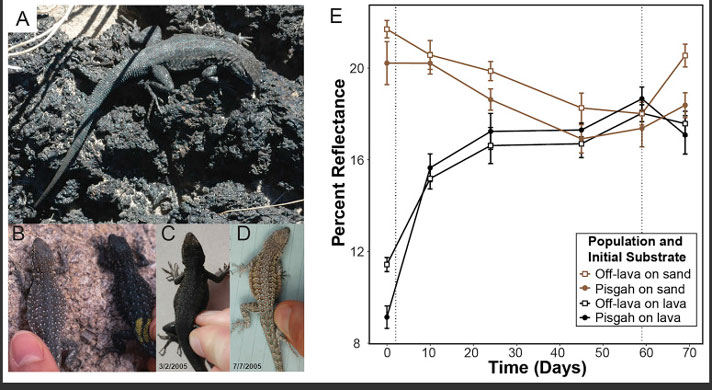A colony of side-blotched lizards living on black lava rock in the Mojave desert of Southern California can change its color after some time living under different conditions.
Most side-blotched lizards in the Mojave Desert of Southern California are tan and brown in coloration, which enables them to blend into the desert environment in which they live. However, there is a colony of the reptiles on the Pisgah Lava Flow that are not tan and brown, but are black, just like the lava rock formations that they call home.

Corl et al., Current Biology, 2018
A. Male Pisgah on lava rock. B. Normal side-blotched lizard and Pisgah lizard that lives on black lava rock. C. Pisgah lizard after five days living off the lava field can be contrasted with D, which is the same lizard after being housed four months in the lab on light-colored sand.
Researchers took a look at both populations of the reptiles and found that "phenotypic plasticity" whereby an animal can alter either its appearance or behavior, or both, to better survive in a new environment, played a role in the physical changes to the population of side-blotched lizards on the lava flow. They were able, through natural selection and via changes in genetics, to adapt to their darker surroundings, in what is known as the “Baldwin effect.”
How Does The Panther Chameleon Change Colors?
The researchers documented how individual lizards on the black lava flows can change colors in the new environment and identified the genes that enabled them to do so, and how those genes are different from those lizards that don’t live on the black lava flow.
"We've studied side-blotched lizards all over, even at another lava flow, and these genetic variants are only found at Pisgah, so we know that's where they arose," Sinervo told UC Santa Cruz Newscenter. "These are genes that govern coloration by controlling the melanin production pathway, but in a complex way. The Pisgah lizards have the best match to the color of the lava of any population, yet they can still go back to sand and match a completely different background."
First author Ammon Corl of the UC Berkeley Museum of Vertebrate Zoology, worked with study co-author, Claudia Luke, whose unpublished thesis describes and discusses the plasticity of the Pisgah side-blotched lizard population.
"Claudia figured out how plastic their coloration is, and I tested for genetic changes that affected coloration in the Pisgah population," Corl told UC Santa Cruz Newscenter. "Baldwin predicted that plasticity allows organisms to colonize new environments, and they then develop new adaptations through natural selection. Until now, however, we have lacked the genetic tools to show this is going on in a field setting."
In addition to looking at both lizard populations, the researchers cross-bred the lizards and measured the coloration of the offspring when raised in a common environment. They determined that the darkness of the lizards skin correlate with variations in melanin-related genes. They also found that the gene variants were only present in the Pisgah lizard population, which they say arose through mutations that occurred in the lizards living on the lava and then spread throughout the population. Those mutations, according to demographic modeling, suggest that the mutations came about thousands of years after the lava flow event, which occurred around 22,000 years ago.
"In some ways, it's amazing that natural selection still acts in the presence of so much plasticity. All it takes is a bit of a mismatch and that can make the difference between life and death," Corl told UC Santa Cruz Newscenter. "There is still variation within the population, so we caught natural selection in the process of acting on these genes. We can now conduct further field and lab studies aimed at better understanding how highly plastic traits are shaped by evolution."
The study, The Genetic Basis of Adaptation following Plastic Changes in Coloration in a Novel Environment, is published in the September 6, 2018 issue of Current Biology.


